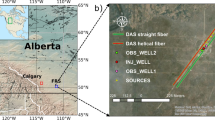Abstract
The inline dipole–dipole time-domain electromagnetic method is a useful supplementary tool for the exploration of a resistive target such as a hydrocarbon resource. Currently, the interpretation of the data from this configuration is based on the fitting of the modeled response and the recorded response in a least square sense. In the paper, we propose an imaging method based on a mathematical transformation named the q-transform, which could make the subsequent imaging of TEM data using the interpretation technique in seismic method possible. The imaging strategy is based on analytical derivation and analysis of the transformed wave-field from which pseudo-velocity and resistivity can be extracted. A numerical test is employed to get the transformed wave-field from the time-domain electromagnetic response with the selected regularization method. The proposed imaging method is tested on the synthetic data obtained from a homogeneous and layered half space models. The results reveal that it is a useful method to recover the resistivity of an underground medium and can provide an additional tool for fast and qualitative imaging of the subsurface resistivity.













Similar content being viewed by others
References
Aster, R. C., Borchers, B., & Thurber, C. H. (2011). Parameter estimation and inverse problems. London: Academic Press.
Bragg, L., & Dettman, J. (1968). Related problems in partial differential equations. Bulletin of the American Mathematical Society, 74, 375–378.
Connell, D. (2011). A comparison of marine time-domain and frequency-domain controlled source electromagnetic methods. San Diego: University of California.
Constable, S. C., Parker, R. L., & Constable, C. G. (1987). Occam’s inversion: A practical algorithm for generating smooth models from electromagnetic sounding data. Geophysics, 52, 289–300.
Danielsen, J. E., Auken, E., Jørgensen, F., Søndergaard, V., & Sørensen, K. I. (2003). The application of the transient electromagnetic method in hydrogeophysical surveys. Journal of Applied Geophysics, 53, 181–198.
Filippi, P., & Frisch, U. (1969). Relation entre l’$ quation de la chaleur et l’$ quation des ondes de Helmholtz. Comptes Rendus Acad Sci, œ68-A(804), 807.
Hai, L., Guo-qiang, X., Nan-nan, Z., & Wei-ying, C. (2015). Appraisal of an array TEM method in detecting a mined-out area beneath a conductive layer. Pure and Applied Geophysics, 172, 2917–2929.
Hansen, P. C. (2010). Discrete inverse problems: Insight and algorithms. London: Siam.
Key, K. (2016). MARE2DEM: A 2-D inversion code for controlled-source electromagnetic and magnetotelluric data. Geophysical Journal International, 207, 571–588.
Lee, K. (1989). A new approach to interpreting electromagnetic-sounding data. Annual Report, 1988, 24–27.
Lee, K. H., Liu, G., & Morrison, H. (1989). A new approach to modeling the electromagnetic response of conductive media. Geophysics, 54, 1180–1192.
Lee, T. J., Suh, J. H., Kim, H. J., Song, Y., & Lee, K. H. (2002). Electromagnetic traveltime tomography using an approximate wavefield transform. Geophysics, 67, 68–76.
Lee, T. J., & Uchida, T. (2005). Electromagnetic traveltime tomography: Application for reservoir characterization in the Lost Hills oil field, California. Geophysics, 70, G51–G58.
Lee, K. H., & Xie, G. (1993). A new approach to imaging with low-frequency electromagnetic fields. Geophysics, 58, 780–796.
Li, H., Xue, G.-Q., Zhou, N.-N., & Chen, W.-Y. (2015). Appraisal of an array TEM method in detecting a mined-out area beneath a conductive layer. Pure and Applied Geophysics, 172, 2917–2929.
Meier, P., Kalscheuer, T., Podgorski, J. E., Kgotlhang, L., Green, A. G., Greenhalgh, S., et al. (2014). Case History Hydrogeophysical investigations in the western and north-central Okavango Delta (Botswana) based on helicopter and ground-based transient electromagnetic data and electrical resistance tomography. Geophysics, 79, B201–B211.
Munkholm, M. S., & Auken, E. (1996). Electromagnetic noise contamination on transient electromagnetic soundings in culturally disturbed environments. Journal of Environmental and Engineering Geophysics, 1, 119–127.
Nabighian, M. N. (1988). Electromagnetic methods in applied geophysics: Application (2 vols.). Xi’an: SEG Books.
Scholl, C., Neumann, J., Watts, M., Hallinan, S., & Mulè, S. (2016). Geologically constrained 2D and 3D airborne EM inversion through cross-gradient regularization and multi-grid efficiency. ASEG Extended Abstracts, 2016, 1–6.
Smith, R. (2014). Electromagnetic induction methods in mining geophysics from 2008 to 2012. Surveys in Geophysics, 35, 123–156.
Spakman, W., van der Lee, S., & van der Hilst, R. (1993). Travel-time tomography of the European-Mediterranean mantle down to 1400 km. Physics of the Earth and Planetary Interiors, 79, 3–74.
Strack, K. M. (1992). Exploration with deep transient electromagnetics. Amsterdam: Elsevier.
Weir, G. (1980). Transient electromagnetic fields about an infinitesimally long grounded horizontal electric dipole on the surface of a uniform half-space. Geophysical Journal International, 61, 41–56.
Wilson, A. J. (1997). The equivalent wavefield concept in multichannel transient electromagnetic surveying. Edinburgh: University of Edinburgh.
Xue, G., Yan, S., Gelius, L., Chen, W., Zhou, N., & Li, H. (2015). Discovery of a major coal deposit in china with the use of a modified CSAMT method. Journal of Environmental and Engineering Geophysics, 20, 47–56.
Ziolkowski, A. (2007). Developments in the transient electromagnetic method. First Break, 25, 99.
Ziolkowski, A., Carson, R., Wright, D. (2007a). New technology to acquire, process, and interpret transient EM data. Presented at the EGM 2007 International Workshop, Italy.
Ziolkowski, A., Hobbs, B., & Wright, D. (2002). First direct hydrocarbon detection and reservoir monitoring using transient electromagnetics. First Break, 20, 224–225.
Ziolkowski, A., Hobbs, B. A., & Wright, D. (2007b). Multitransient electromagnetic demonstration survey in France. Geophysics, 72, F197–F209.
Acknowledgements
This research was supported by R&D of Key Instruments and Technologies for Deep Resources Prospecting (the National R&D Projects for Key Scientific Instruments), Grant No. ZDYZ2012-1-05-04. We are grateful to constructive feedback by two anonymous reviewers.
Author information
Authors and Affiliations
Corresponding author
Rights and permissions
About this article
Cite this article
Li, H., Xue, Gq. & Zhao, P. A New Imaging Approach for Dipole–Dipole Time-Domain Electromagnetic Data Based on the q-Transform. Pure Appl. Geophys. 174, 3939–3953 (2017). https://doi.org/10.1007/s00024-017-1603-1
Received:
Revised:
Accepted:
Published:
Issue Date:
DOI: https://doi.org/10.1007/s00024-017-1603-1




